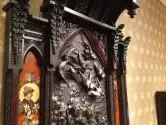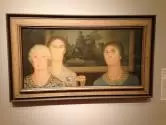Smart — or Lucky?

Which would you rather be: smart or lucky?
Turns out a few weeks ago I was luckier than I was smart.
I had been planning on using my annual journey back to Illinois for the Johnson family reunion as a research trip as well, packing up my car with food and drinks and driving rather than flying there. I left Asheville on a Monday morning with Cincinnati an easy first day’s drive north.
I chose Cincinnati because of its extensive collection of art-carved furniture (pictured), nearly all of which had been carved at the School of Design and the Art Academy of Cincinnati under the direction of William and Henry Fry, as well as Benn Pitman, all English-trained carvers of national prominence.
My interest in art-carved furniture was motivated by Eleanor Vance, who with her life partner Charlotte Yale, founded Asheville’s Biltmore Estate Industries in 1905 and Tryon Toymakers and Woodcarvers in 1915. Both were North Carolina Arts and Crafts cottage industries which hired and trained hundreds of young men and women living in the Blue Ridge Mountains.
Eleanor Vance, I had discovered, grew up in Cincinnati and attended the School of Design, where for nearly nine years she studied, worked, and carved under the tutelage of Benn Pitman and Henry Fry.
So, when I arrived at the Cincinnati Art Museum on Tuesday morning, I headed straight for the wing containing examples of Pitman’s and others’ art-carved furniture, throwing only an occasional glance at the other works of art along the way. I was not disappointed in the extensive exhibit, which included numerous examples of their work, lengthy descriptions, and critical background information, as well as a streaming video of the wood carving process. I absorbed it all like a dry sponge, and by lunch was ready to burst back through the massive doors into the bright August sunshine, find an outdoor café for lunch, and start typing my notes into my laptop.
On my way toward the doors, however, I paused at the sight of the museum’s Collection Catalog, a hefty, dog-eared paperback, lying on a table. Curious, I reached out and flipped it open to a random page near the middle of the book.
That’s when I got lucky.

There on the open page was a photograph of one of Grant Wood’s most iconic paintings, Women of Revolution (pictured). As you may recall, Grant Wood is also a favorite of mine, as we both grew up on the rolling Midwestern prairie. While most people immediately associate Wood with American Gothic, he also completed nineteen lithographs between 1937 and his death in 1942. They are the subject of another of my current book projects, Grant Wood: The 19 Lithographs.
I have had as one of my goals experiencing in person each of Grant Wood’s most famous oil paintings, including his satiric Women of Revolution. But as I suffer from an extreme case of tunnel vision, I had completely forgotten that the Cincinnati Art Museum owned an original oil painting by Grant Wood.
Not so smart.
Had I not been lucky that Tuesday morning, I would have blown right past it, along with a great Edward Hopper oil hanging next to it, on my way to a sandwich and a glass of wine. I would have forever chastised myself for not pulling my head out of the sand and looking around that morning to see whatever gems the museum had in its collection.
As it was, I was lucky rather than smart that morning, and got to meet the three prim ladies waiting there inside the museum.

Until next Monday,
Which would you rather be?
Bruce
Next Monday: Standing inside a Rookwood kiln.
